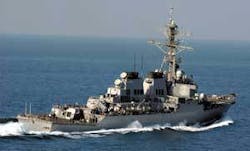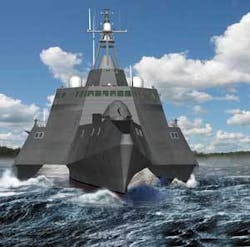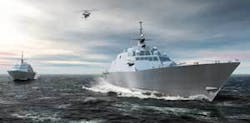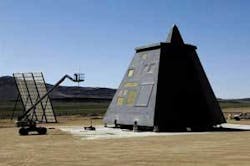Growth of the U.S. Navy’s fleet of surface warships and submarines is riding on systems innovation and new technologies to introduce open-systems solutions for network-centric warfare, ballistic-missile defense, and other capabilities for the 21st century maritime warfare.
By Ed Walsh
U.S. Navy leaders are looking at a blend of systems upgrades, technology insertion, and new technology development to help them meet the latest challenges of modern ocean warfare.
Leaders are seeking the right technological mix to equip surface ships and submarines for network-centric warfare, cooperative engagement, and sensors integration, while at the same time improving existing platforms to enhance interoperability, affordability, and reliability.
They are grappling with tight military budgets, as well as the need to increase numbers and capabilities of ships in the U.S. fleet, and they are looking at electronic and optoelectronic technologies to help them maintain a fighting edge.
The Navy has started 2006 confronting many familiar challenges. Adm. Michael Mullen took charge as chief of naval operations (CNO) trying to do as his predecessor did-win more performance and lower costs from technology and management innovation to compensate for fewer ships, more demanding missions, and severe funding constraints. Mullen replaced Adm. Vern Clark as CNO in July 2005.
The Navy plans to equip 15 of its Arleigh Burke-class (DDG-51) Aegis destroyers with its ballistic missile defense capabilities. The Burke program will end with the 62nd ship (DDG-112).
Mullen, in his first “CNO Guidance,” reaffirmed Clark’s goals of developing the weapon, sensor, logistics, and information-management capabilities. The key planks of Clark’s Sea Power 21 strategic vision, which Mullen maintains, are called Sea Strike, Sea Shield, Sea Basing, and FORCEnet-the Navy’s new information management plan.
The new CNO’s guidance calls for strong Navy support for the global war on terror, including establishing adaptive Navy-Marine Corps force packages and flexible deployment. Mullen also endorsed a joint fire-support strategy for Sea Strike, development of a Sea Shield Missile Defense and related Sea Basing concept of operations, and aligning FORCEnet information-management integration efforts with joint planning and investments.
In a move aimed at reversing the decline in the fleet size, Mullen introduced a long-term plan last fall to increase the number of ships, now at about 280, to about 333 ships by 2019. The fleet would stay at that level through 2035.
Navy officials say that meeting such a shipbuilding goal will require tighter controls on ship-design and construction costs. In late 2005 the Navy projected the cost of the lead DD(X) land-attack destroyer at $3.3 billion. Design changes and production process improvements have cut the price for follow-on DD(X) ships to $3.1 billion each.
Mullen’s planning calls for the nation’s shipbuilding budget to rise to more than $13 billion annually, a considerable hike from the $8.7 billion in fiscal 2006, although the plan cuts the attack submarine fleet from 52 today to 48, and aircraft carriers from 12 to 11.
New shipbuilding projects
The DD(X) is to be one of the newest warships in the Navy’s inventory. In November 2005 Kenneth Krieg, the Defense Department’s undersecretary for acquisition, technology, and logistics, approved a milestone B plan for the DD(X), enabling the program to start its System Development and Demonstration phase, which encompasses detail design and lead-ship construction.
The plan calls for Northrop Grumman Ship Systems in Pascagoula, Miss., lead DD(X) shipbuilder, and General Dynamics Marine Systems/Bath in Bath, Maine, to build the first and second ships simultaneously, beginning in 2007. Navy leaders are set to build seven DD(X) ships, a major retreat from the Navy’s original plan for 24 ships.
The DD(X) National Team, led by Northrop Grumman, includes General Dynamics, Lockheed Martin, Raytheon, and BAE Systems. Raytheon leads the DD(X) systems team, made up of Lockheed Martin, United Defense LP, and several smaller companies.
null
In June 2005 the Lockheed Martin-led industry team building the littoral combat ship (LCS) laid the keel for the first “Flight 0” ship, Freedom. The Navy hopes to build 55 LCSs, a critical element of the expanded fleet. General Dynamics/Bath will build a second Flight 0 ship. A second flight, called Flight 1, which will add new capabilities, will start construction in 2008.
As in recent years, a critical plank of cost cutting is upgrading the capabilities of individual platforms through technology insertion and new management techniques. Navy officials last year ordered the Program Executive Office for Integrated Warfare Systems (PEO IWS) to extend its “Open Architecture” (OA) initiative from the surface-warfare fleet to submarine and naval aviation.
Capt. Jim Shannon, major program manager for OA in PEO IWS, says that including aircraft and submarines reinforces the “transformational” influence of the OA initiative, which started in the late 1990s as an attempt to develop an open-architecture computing environment (OACE).
The OA, which aims mainly at surface ship combat systems, is chiefly for the Aegis system aboard the Ticonderoga-class cruisers and Arleigh Burke-class destroyers, as well as for the ship self-defense system (SSDS) being fielded to aircraft carriers and amphibious assault ships. The goal, officials say, is to end the perennial lack of interoperability among shipboard combat systems through the insertion of commercial processing technology.
Aegis combat system
The Aegis combat system, developed by prime contractor Lockheed Martin, consists of the SPY-1 wide-area phased-array search radar, weapon control system (WCS), command & decision system (C&D), fire-control system (FCS), Aegis displays, operational readiness test system (ORTS), and Aegis training system.
Aegis was designed to run target detection, track correlation and management, navigation, and fire-control programs written in Navy-unique CMS-2 software language on Navy-proprietary UYK-43 and UYK-44 computers. Prior to baseline 6, now fielded, Aegis computer hardware and software were tightly coupled, requiring complex modifications to both when upgrades were introduced.
Navy and Lockheed Martin officials say that the early Aegis design approach cannot accommodate the extensive upgrades required for new fleet missions, such as ballistic missile defense, without extensive and unaffordable systems engineering.
Baselines 5 phase 3 and 6 introduced “adjunct” commercial processors linked to the UYK computers through middleware for many system functions. The move to commercial off-the-shelf (COTS) equipment a decade ago started the decoupling of Aegis functions from the proprietary hardware and software.
Baseline 7 phase 1, certified for fleet use in September 2005, shifts the system to a fully commercial architecture based on the Navy-standard UYQ-70 shipboard processor.
The Navy’s controversial DD(X) destroyer will showcase new acquisition and systems-engineering innovations, but costs have limited the number to be built.
The Navy is also using Aegis as the foundation for the sea-based leg of the national missile defense system. Ten Burke-class destroyers have been fitted with a long-range surveillance and track (LRS&T) capability and two Aegis cruisers have been equipped with an emergency engagement LRS&T.
In November 2005, the cruiser USS Lake Erie (CG 70), the Navy’s sea-based missile-defense test ship, fired an SM-3 Standard missile that intercepted a separating missile target off Kauai, Hawaii, during its midcourse flight phase-the sixth successful sea-based ballistic missile defense test.
The Navy plans eventually to equip 15 destroyers and three cruisers with the LRS&T capability to engage short- and medium-range ballistic missiles.
Open-architecture effort
The OA initiative identifies combat-system functions common to all ship classes and cites commercial software standards, for example, POSIX and CORBA, which can be used by to port functions among several processing systems. The application of new standards to functions, through a series of performance goals, enables systems to become more “open.”
Rueben Pitts III, major program manager for integrated combat systems for PEO IWS, says that “OA is an adjective, not a noun-it describes a condition when you’re compliant with a set of standards. When you use OA standards to comply with those standards, you’re open.”
He says that “Category 3 OA represents a state when hardware and software are independent of each other,” permitting software and hardware upgrades in a step called “ungluing the stack,” without the need to modify hardware and software, Pitts says.
Lockheed Martin officials say that Aegis baseline 7 phase 1 will be OA-compliant by 2007. It incorporates Concurrent Computer Corp.’s PowerMaxion and PowerHawk real-time Unix processors for the Aegis WCS and FCS, running the PowerMax operating system with the Power Works toolset.
Eight PowerMaxion symmetric multi-processors are embedded in the Aegis SPY-1D(v) radar. The WCS, FCS, and C&D use Power Hawk single-board computers. Aegis subsystems, including the Aegis combat training system and ORTS also incorporate Motorola 2604 Power PC processors. The Aegis display system runs on HP-744, an upgrade to the HP-743 processor used in the early UYQ-70.
Lockheed Martin engineers are developing a baseline 7 phase 1 refresh, which will include new displays and Cisco switch technology, and will be introduced aboard the Burke-class destroyer USS Truxton (DDG 103).
The refresh development is running in tandem with new Aegis system development for the Navy’s cruiser conversion program, which will bring the Navy’s 23 Ticonderoga-class cruisers into OA compliance by 2008. The cruiser USS Bunker Hill (CG 52), the first of the Ticos equipped with the Mk 41 vertical-launch system, will be the first OA cruiser.
Shannon says the model for moving toward OA compliance, for aircraft and submarines as well as for surface ships, is the acoustic rapid COTS insertion (ARCI) program developed by the Navy’s attack program office to upgrade processing architectures for the Los Angeles-class fast-attack submarines.
The ARCI approach identifies necessary capabilities required and seeks rapid insertion of processing components through the use of middleware developed initially for the ARCI by DSR Inc., which was acquired by General Dynamics in September 2003.
The OA effort, he says, is shifting the Navy from a systems-of-systems focus to a “family” of systems approach represented by the FORCEnet architecture, which integrates several systems in force-wide networks of weapon, sensor, and command, control, communications, computer, and intelligence (C4I) systems.
Pitts and Shannon stress that the OA initiative is looking hard for relatively small companies agile enough to provide key technology enhancements for rapid insertion into OA environment.
Real Time Innovations Inc. (RTI) of Santa Clara, Calif., for example, has developed network data-delivery service (NDDS) networking software middleware that complies with the OA data distribution service (DDS) standard, and with standards established for the U.S. Department of Defense (DOD) Global Information Grid (GIG) and other defense networking applications.
Gordon Hunt, principal engineer for RTI, says the NDDS is a “communications infrastructure” for managing and configuring data. The company started the work to support the Naval Surface Warfare Center’s Dahlgren Division, which designed OA standards. The NDDS middleware serves as a “library” between the operating system and the application program.
Hunt says the NDDS meets the OA standard for data delivery for systems such as radars, which exchanged data with signal emitters, track correlators, and displays.
A key element of the product is its use of Quality of Service functionality to configure systems and establish “multilayered” links between data users and providers. The company developed NDDS 3.1 prior to the release of the DDS standard, and has completed a newer version 4.0. A subsequent version 4.1, scheduled for release this spring, will be fully OA-compliant.
Navy processor hardware also must comply with OA standards. Lockheed Martin Tactical Systems in Eagan, Minn., prime for the UYQ-70 family of advanced display processors, won several contracts for new systems that will incorporate OA standards. The UYQ-70 display and processor has been sold to the Australian, German, Japanese, Norwegian, and Spanish navies.
Company officials stress that the open UYQ-70 architecture represents a “framework” for technology insertion, and can be configured to accommodate wide range of processing requirements. The UYQ-70 family, used by all Aegis components, provides a next-generation peripheral, command processor, airborne and acoustic processors, workstations for submarine use, and airborne installations aboard E-2C Hawkeye aircraft.
The Navy’s FORCEnet, which Shannon calls the model for the OA architecture, is envisioned as information-management networks and systems that will link deployed fleet units as well as weapons, sensors, and C4I systems with joint forces and the DOD GIG. The Naval Network Warfare Command and PEO for C4I are leading the FORCEnet development.
In January the Navy selected Lockheed Martin, teamed with BAE Systems, to act as lead engineer for its Distributed Information Operations project, which company officials say will provide a framework for FORCEnet by supporting C4I system interoperability through enhancements to the Navy’s distributed common ground system (DCGS-N).
Cooperative Engagement
In the area of systems, the Naval Sea Systems Command in late 2005 awarded Raytheon Network Centric Systems a $7.1 million contract for new components of the cooperative engagement capability (CEC) suite that is being fielded to the Ticonderogas, Burkes, carriers, Wasp- and San Antonio-class amphibs, the DD(X), and the LCS.
CEC, consisting of a cooperative engagement processor, data-distribution set, and antenna, consolidates transfers air-target tracking data from radars of ships participating in a CEC network into a common data picture.
The contract covers new planar-array antenna assemblies (PA3s) that replace the older donut-shaped antennas that are clamped onto ship masts. In current installations, the antenna field of view is blocked by the ship’s deckhouse, requiring a second antenna. A single PA3, which is fitted with four array faces, eliminates the need for the second antenna.
Raytheon engineers are continuing to insert commercially developed technology into the CEC architecture, first developed in the mid-1980s. Currently the company is developing a mini-terminal that uses commercial processors to reduce the size of the data terminal of the Block 1 CEC from 2,000 pounds to around 55 pounds.
Company officials say they expect to have a production contract for the mini-terminal by mid-2006. Raytheon also has replaced 39 individual Block 1 processing cards with four quad cards, each of which accommodates four microprocessors, and is porting CEC application programs from the old Navy-unique CMS-2 language to C++.
Like other critical combat system interfaces, CEC must become OA compliant. Raytheon is developing software necessary to meet OA Category 3 interoperability for Aegis, the ship-self defense system, the DD(X) computing environment, as well as mission computing for the new Hawkeye E-2D surveillance aircraft.
Electronic warfare
A longtime Raytheon shipboard program, the SLQ-32 electronic warfare system, is going through a measured series of enhancements, called the surface electronic warfare improvement program (SEWIP), that eventually will become a wholly new system. General Dynamics Advanced Information Systems is supporting the SEWIP work.
In October 2005 the Navy awarded General Dynamics a $4.2 million contract for eight units of a small-ship electronic warfare system (SSESM) that will provide “specific emitter identification.”
The company says that SSESSM will improve operator situation awareness by adding electronic support capabilities developed by the Naval Research Laboratory, as well as special signal detection, processing, network-centric warfare capabilities, and display enhancements.
The PEO IWS is looking at a series of block upgrades, labeled 1A, 1B, and 1C. General Dynamics officials say the Block 1A system, now installed for testing aboard the Burke-class destroyer USS Ramage (DDG 61), adds for the SLQ-32 a suite of COTS components that provides an upgraded control human-machine interface and electronic surveillance enhancements.
Block 1B inserts the SSESM. Block 1C is expected to consist of a high-gain antenna and an interface to the Global Information Grid, and will support launch of the Nulka active on-board decoy. The General Dynamics effort for SEWIP is led by the former Digital System Resources, which won a Navy contract in July 2003 to act as lead integrator for the program.
The SEWIP program started in late 2002 when the Navy terminated a program to develop an advanced integrated electronic warfare system (AIEWS) then planned as the EW suite for the DD(X).
To fill the gap, the DD(X) program opted to adapt the electronic warfare component of an Office of Naval Research (ONR) program started in the late 1990s to produce an advanced multifunction radio-frequency concept (AMRF-C). That effort, now referred to as “Integrated Topside,” aims at developing a set of antenna apertures for surface ships that would be capable of handling broadband communications, radar, and electronic warfare signals.
Lockheed Martin, Raytheon, and Northrop Grumman’s Electronic Systems Sector are participating in the AMRF-C program, which last year went through extensive demonstrations at the Naval Research Laboratory’s Chesapeake, Md., site.
The EW segment, called multifunction EW (MFEW), is going through a spiral development, beginning with a technology development phase to produce high- and mid-band receive-array antennas, an analog receiver, digital receiver/beamformers, and an electronic surveillance processor. Subsequent spirals will add more capability both for DD(X) and other ship classes.
New ships
Last May the Navy awarded Raytheon Integrated Defense Systems a $3 billion contract for continuing work on DD(X) mission equipment. In September 2005 the DD(X) went through a successful system-wide critical design review that evaluated work on 10 engineering development models of DD(X) systems, among them the advanced gun system, total ship computing environment, dual-band radar, integrated deckhouse, and peripheral vehicle launch system. The CDR set the stage for the November Milestone B approval.
DD(X) also has been billed as the Navy’s first major ship fitted with an integrated electric-drive power architecture, designated the Integrated Fight Through Power System (IFTS).
General Dynamics Bath is the industry lead for the IFTS. The DD(X) program planned initially to use a high-torque permanent magnet motor developed by DRS Technologies for the power architecture, but shifted instead to a more conventional and reliable advanced induction motor built by Alstom. The Alstom motor also is going aboard the United Kingdom Royal Navy’s Type 45 destroyers.
The PEO for Ships says that DD(X) is the “centerpiece” of the Navy’s new family of ships that also includes the LCS and next-generation cruiser, CG(X).
The Lockheed Martin LCS is designed as a high-speed planing monohull with a steel hull and aluminum deckhouse. The Lockheed Martin team, now building Freedom (LCS-1), also will build LCS-3. The General Dynamic design is a trimaran with a slender stabilized monohull.
The GD Marine Systems unit leads the team that will build LCS-2 and -4. Both LCS designs will be capable of speeds as fast as 50 knots, a range of 1,500 nautical miles at top speed, and of about 4,300 nautical miles at 20 knots cruising speed.
The LCS will be fitted with a helicopter hangar to support the MH-60R rotorcraft, the Fire Scout unmanned aerial vehicle, AQS-20 towed mine-hunting multiple-beam sonar, an unmanned ribbed boat, and Spartan unmanned surface vehicle to be equipped with a navigation radar, infrared camera, and video camera. The vehicle may be armed with an anti-surface missile system or gun, as well as mine-detection sonar.
The key LCS technology innovation is for the interchangeable mission modules to support the three LCS missions: mine warfare, antisubmarine warfare, and antisurface warfare.
The modules will provide the sonars, missile launchers, gun mounts, and other systems necessary for each of the missions. In January the Navy awarded to Northrop Grumman Integrated Systems a contract potentially worth $159 million to integrate the modules, which can be changed out within 24 hours.
The LCS class will be the Navy’s first “network-centric” class, configured for compatibility with the FORCEnet architecture.
The Navy in early 2005 launched its experimental surface demonstrator, or “X-Craft,” the Sea Fighter, a 262-foot-long aluminum-hulled catamaran that displaces 950 tons. The Sea Fighter, funded by ONR, will serve as a test bed for arrangement for LCS mission modules and for the sea-keeping performance of the catamaran hull.
ONR continues to look at innovative technologies for future ships. In October 2005 it awarded DRS Electronic Systems a $5.9 million contract to study designs for a low-cost C-band fixed active-array radar, antenna design, and antenna module.
In December, ONR also awarded a phase 3 small business innovative research (SBIR) contract valued initially at $6.7 million to General Dynamics for work on middleware to support open-architecture processing for ship sensor, weapon, and combat-system designs.
Alternative propulsion systems
Also in late 2005, ONR and the Naval Sea Systems Command, responding to CNO guidance, produced a study of alternate propulsion system methods for surface ships and submarines that predicted the fitting out of future ships with electric weapons, sensors, launchers and propulsion systems. The study added that the “major barrier to achieving an all-electric Naval Force is the power density of electric propulsion systems.”
The DD(X) is pushing several research efforts. ONR has awarded a new contract to the Power Systems Group (PSG) of L3 Communications’ SPD Technologies business unit for a second phase of work on an advanced propulsion motor drive. The so-called “quiet drive” demonstrates the use of new power components and software controls to reduce dramatically the electrical noise and harmonics of ship propulsion systems.
The first phase started in late 2004 to simulate and model a methodology for generating the drive waveform. The second phase, to be conducted at the Naval Surface Warfare Center in Philadelphia, will test a model that can be scaled up to support any Navy ship motor, including the Alstom DD(X) advanced induction motor. PSG also is seeking to build a common power module for the LCS mission modules that will convert ship’s power to the specific voltage outputs necessary for the systems of each module.
In another key development for ship power, the Navy awarded a contract to Northrop Grumman Marine Systems and American Superconductor to develop a 40-megawatt high-temperature superconductor motor. The contract funds a nine-month study. Navy officials say the motor could be ready for the third DD(X).
Shipboard electronics glossary
AMRF-C-advanced multi-function radio frequency concept
C4I-command, control, communi-cations, computer, and intelligence
C&D-command & decision system
CEC-cooperative engagement capability
CNO-chief of naval operations
COTS-commercial off-the-shelf
DCGS-N-distributed common ground system-Navy
DDS-data distribution service
FCS-fire-control system
GIG-Global Information Grid
IFTS-Integrated Fight Through Power System
LCS-littoral combat ship
LRS&T-long-range surveillance and track
OA-Open Architecture
OACE-open-architecture computing environment
ONR-Office of Naval Research
ORTS-operational readiness test system
PA3-planar-array antenna assembly
PEO IWS-Program Executive Office for Integrated Warfare Systems
SBIR-small business innovative research
SEWIP-surface electronic warfare improvement program
SSDS ship self-defense system
SSESM-small-ship electronic warfare system
WCS-weapon control system




